Sun in Hydrogen Alpha / CaK
With Coronado 40 / Lunt 60mm CaK
Uploaded 9/26/11

| Only
once in a great while does persistence and good fortune come
together on a shooting session to make an average imaging experience
into a remarkable one. Today was such a fortuitous morning. The
sun rose past the lip of the observatory wall at around 7:30
this morning, and the view in the hydrogen alpha scope revealed
a very strong solar flare - possibly X class, was ramping up
on the oncoming limb. The sky stayed totally clear for this shooting
session and that is pure luck during our Arizona Monsoon season!
As we continued to record the flare, I did my usual off band
checks and found that in the Blue wing of the Halpha line a huge
surge prominence was erupting like a ghostly shadow away from
the flare at a high rate of speed. As we watched for over an
hour, the flare peaked in brightness, and the spray of plasma
changed minute by minute. I was able to record some of these
changes in the images below. Interestingly, the CaK images do
not reveal much at all, even during the maximum flaring. |
Click on Images for a larger 1024 or 800 sized view
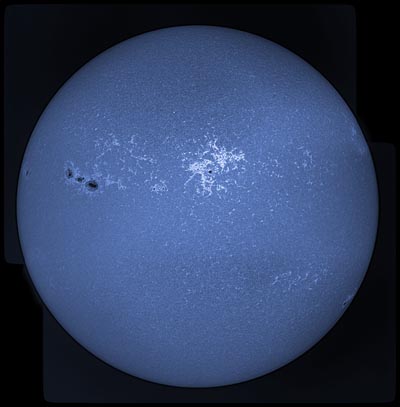 |
Overview in the Calcium K absorption line
(Yes the "P" angle is correct) On the left
edge is a monster sunspot group, dominated
by AR11302 which is the entire group desig-
nation. Little faculae surrounds this ominous
feature. Just to the right of center a huge
faculae complex surrounds AR1304. The
thin wisps on the upper right edge is the remains
of AR1298, and on the bottom right edge we
find the disappearing AR1303.
|
First we will overview the features on the disk with the CaK which most
resembles the white light view:
With 2x Coronado Barlow
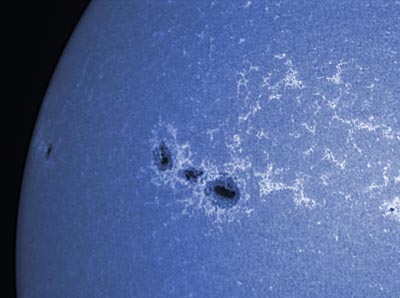 AR1302 a huge triple sunspot the small spot
on the limb has no number yet
AR1302 a huge triple sunspot the small spot
on the limb has no number yet
|
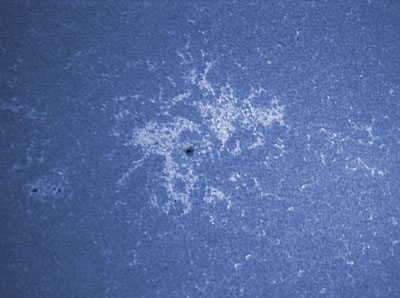 AR1301 has plenty of faculae around it hinting
of more increased activity to come
AR1301 has plenty of faculae around it hinting
of more increased activity to come
|
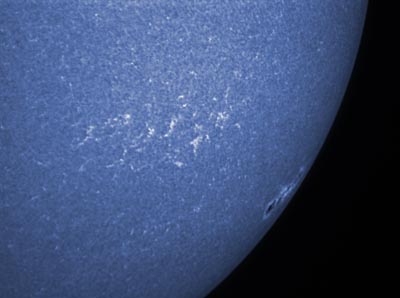 AR1303 is moving off the disk
AR1303 is moving off the disk
|
The
first image up at top surprisingly does not
show
a hint of flaring action, which was
apparently
confined to Halpha.
|
Next, the Halpha data:
With 3x Klee Barlow
Low contrast Images to show the Flare clearly:
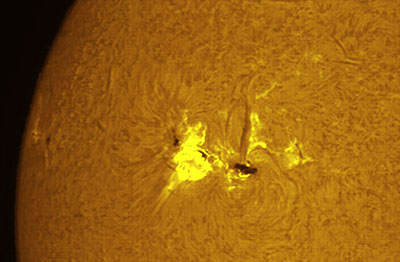 AR1302 at maximum flare. Ive processed the
disk normally here blowing out the flare
AR1302 at maximum flare. Ive processed the
disk normally here blowing out the flare
|
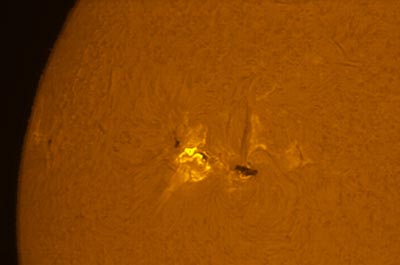 A very low contrast view showing the start
of the flare in detail
A very low contrast view showing the start
of the flare in detail
|
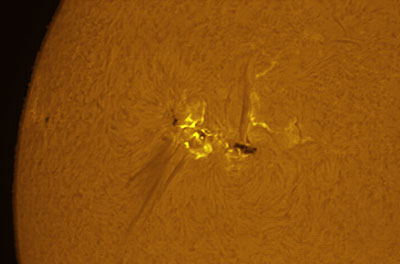 About 10 minutes after flare start
About 10 minutes after flare start
|
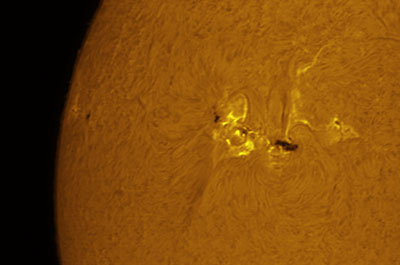 About 30 minutes after flare start
About 30 minutes after flare start
|
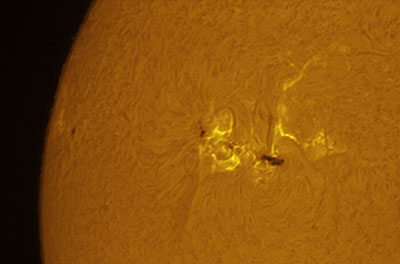 About 45 minutes after flare start
About 45 minutes after flare start
|
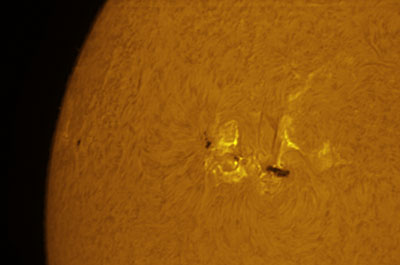 About 60 minutes after flare start
About 60 minutes after flare start
|
Blue Wing Hydrogen Alpha data tuned for best detail
in the eruptive prominence flow
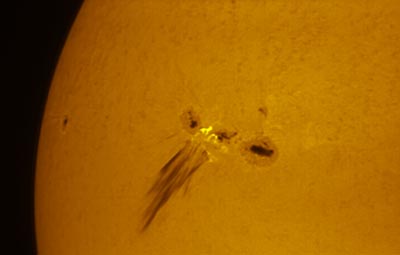 A few minutes after the flare occurred
this amazing surge prominence was seen
A few minutes after the flare occurred
this amazing surge prominence was seen
|
The Coronado has a tuning assembly which allows
manual adjustment of the wavelength about plus
or minus 2 angstroms. By tuning the frequency to
the blue end, you can see Doppler shifted plasma
that is approaching you at high speed.
When I tuned to the red wing, little was seen
indicating that most of the material was
still being ejected.
|
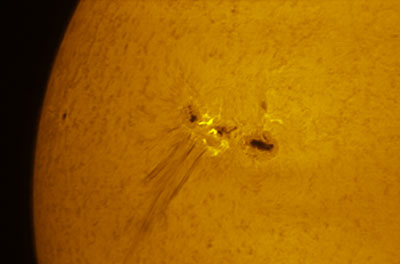 +15 minutes
+15 minutes
|
The
prominence quickly started to fan out
|
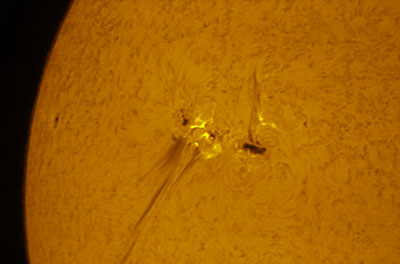 +20 minutes
+20 minutes
|
The
flow seemed to be slowing but now
the
second flow from the big spot is starting
|
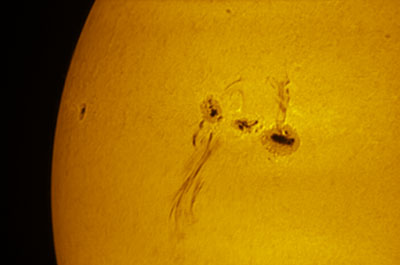 +30 minutes
+30 minutes
|
The
last few tendrils are becoming very
curved.
I could not see any more in either red or
blue
wings.
|
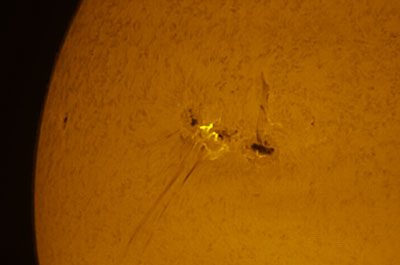 +45 minutes
+45 minutes
|
Very
faint now, all bands seem nearly empty
|
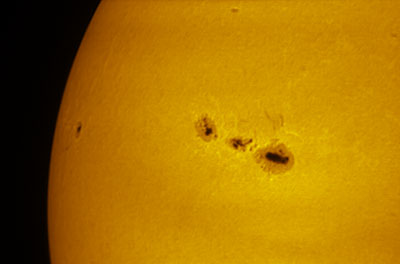 + 60 minutes
+ 60 minutes
|
Finally,
after an hour, it was all over. This is
still
a blue wing shot.
|
Additional Halpha images taken after the Flare
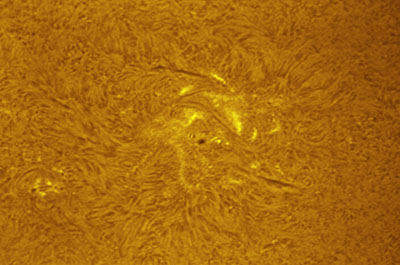
|
AR1301
in Halpha light
|
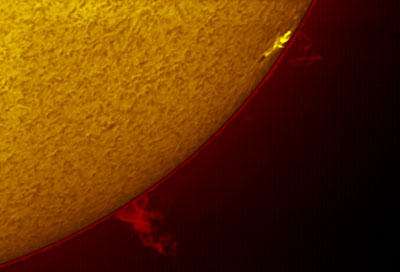
|
Western
Limb prominences are
easily
seen, the lower one seems to have
a
corkscrew appearance.
|
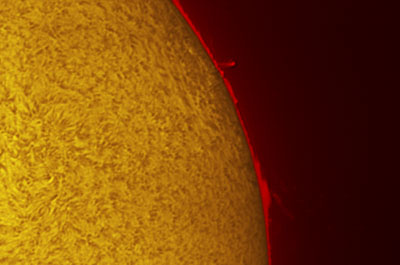
|
More
proms on the calm western limb.
the
red fringe around the disk is the spicules,
and
I was very careful not to overexpose them!
|
|
|
 Instrument: Coronado 40mm Halpha or Lunt 60mm CaK
Platform: Astrophysics 1200
Camera: DMK 3U (1024x768)
Location: Payson, Arizona
Elevation: 5150 ft.
Sky: Seeing 6/10, Transparency 9/10
Outside Temperature: 75F
Processing: Registax 6, Photoshop CS2
Solar Home Page
HOME SCHMIDT GALAXIES EMISSION NEBS REFLECTION NEBS COMETS
GLOBULARS OPEN CLUST PLANETARIES LINKS
Instrument: Coronado 40mm Halpha or Lunt 60mm CaK
Platform: Astrophysics 1200
Camera: DMK 3U (1024x768)
Location: Payson, Arizona
Elevation: 5150 ft.
Sky: Seeing 6/10, Transparency 9/10
Outside Temperature: 75F
Processing: Registax 6, Photoshop CS2
Solar Home Page
HOME SCHMIDT GALAXIES EMISSION NEBS REFLECTION NEBS COMETS
GLOBULARS OPEN CLUST PLANETARIES LINKS
|

Instrument: Coronado 40mm Halpha or Lunt 60mm CaK Platform: Astrophysics 1200 Camera: DMK 3U (1024x768) Location: Payson, Arizona Elevation: 5150 ft. Sky: Seeing 6/10, Transparency 9/10 Outside Temperature: 75F Processing: Registax 6, Photoshop CS2 Solar Home Page HOME SCHMIDT GALAXIES EMISSION NEBS REFLECTION NEBS COMETS GLOBULARS OPEN CLUST PLANETARIES LINKS


















